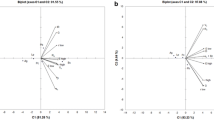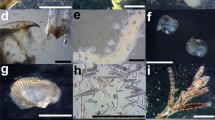Abstract
Centropages tenuiremis is a species with a wide distribution range in disturbed coastal waters. However, due to a lack of dietary information, it remains unclear as to how they maintain such dominance in fluctuating conditions. In this study, C. tenuiremis was collected from the Daya Bay Nuclear Power Plant both in inlet and outfall regions at 06:00, 12:00 and 18:00 on April 27, 2011 and their in situ diet was analyzed using a PCR protocol targeting 18S ribosomal genes. Thirty-four species of prey organisms were identified totally, including Dinophyta, Baciliariophyta, Viridiplantae, Rhizaria, Apicomplexa, Chordata, Mollusca, Arthropoda and Fungi, indicating an obvious omnivorous feeding habit of C. tenuiremis. Centropages tenuiremis obviously exhibited spatial and temporal variations in diet composition. More plant prey (land plants and phytoplankton) were consumed in the morning (~50%), while more animal prey (metazoans and protozoans) were ingested at midday and night (60%–70%). Furthermore, a more diverse diet was detected in the outfall region (10–11 taxa), where the temperatures were relatively higher and more fluctuating, than in the control region (5–10 taxa). This finding indicated that C. tenuiremis could potentially expand its food spectrum under stressful condition. Specifically, C. tenuiremis exhibited phytoplankton preference (58.62%–67.64%) in the outfall region with a lower omnivory index (0.27–0.35) than in the control region (0.51–0.95). However, phytoplankton density was lower than that in the control region, suggesting a possible herbivorous tendency of C. tenuiremis under elevated temperatures to balance the energy acquirement and feeding effort. The flexible food choices of C. tenuiremis observed here could effectively buffer environmental fluctuations and might be an important survival strategy in coastal ecosystems.
Similar content being viewed by others
References
Barbier E B, Hacker S D, Kennedy C, et al. 2011. The value of estuarine and coastal ecosystem services. Ecological Monographs, 81(2): 169–193, doi: 10.1890/10-1510.1
Benedetti F, Gasparini S, Ayata S D. 2016. Identifying copepod functional groups from species functional traits. Journal of Plankton Research, 38(1): 159–166, doi: 10.1093/plankt/fbv096
Boersma M, Mathew K A, Niehoff B, et al. 2016. Temperature driven changes in the diet preference of omnivorous copepods: no more meat when it's hot?. Ecology Letters, 19(1): 45–53, doi: 10.1111/ ele.12541
Calbet A. 2001. Mesozooplankton grazing effect on primary production: a global comparative analysis in marine ecosystems. Limnology and Oceanography, 46(7): 1824–1830, doi: 10.4319/lo.2001. 46.7.1824
Calbet A, Carlotti F, Gaudy R. 2007. The feeding ecology of the copepod Centropages typicus (Kröyer). Progress in Oceanography, 72(2-3): 137–150, doi: 10.1016/j.pocean.2007.01.003
Carlotti F, Harris R. 2007. The biology and ecology of Centropages typicus: an introduction. Progress in Oceanography, 72(2-3): 117–120, doi: 10.1016/j.pocean.2007.01.012
Carstensen J, Klais R, Cloern J E. 2015. Phytoplankton blooms in estuarine and coastal waters: seasonal patterns and key species. Estuarine, Coastal and Shelf Science, 162: 98–109, doi: 10.1016/j.ecss.2015.05.005
Chao A. 1984. Nonparametric estimation of the number of classes in a population. Scandinavian Journal of Statistics, 11(4): 265–270
Christensen V, Pauly D. 1992. ECOPATH II—a software for balancing steady-state ecosystem models and calculating network characteristics. Ecological Modelling, 61(3-4): 169–185, doi: 10.1016/0304-3800(92)90016-8
Daan R, Gonzalez S R, Klein Breteler W C M. 1988. Cannibalism in omnivorous calanoid copepods. Marine Ecology Progress Series, 47: 45–54, doi: 10.3354/meps047045
Dagg M. 1977. Some effects of patchy food environments on copepods. Limnology and Oceanography, 22(1): 99–107, doi: 10.4319/lo.1977.22.1.0099
Floeter S R, Behrens M D, Ferreira C E L, et al. 2005. Geographical gradients of marine herbivorous fishes: patterns and processes. Marine Biology, 147(6): 1435–1447, doi: 10.1007/s00227-005-0027-0
Gao Yahui, Li Song. 1990. Observational experiments on feeding rates of Centropages tenuiremis. Tropic Oceanology (in Chinese), 9(3): 59–65
Garrido S, Cruz J, Santos A M P, et al. 2013. Effects of temperature, food type and food concentration on the grazing of the calanoid copepod Centropages chierchiae. Journal of Plankton Research, 35(4): 843–854, doi: 10.1093/plankt/fbt037
Gaudy R, Thibault-Botha D. 2007. Metabolism of Centropages species in the Mediterranean Sea and the North Atlantic Ocean. Progress in Oceanography, 72(2-3): 151–163, doi: 10.1016/j.pocean. 2007.01.005
Guo Zhiling, Liu Sheng, Hu Simin, et al. 2012. Prevalent ciliate symbiosis on copepods: high genetic diversity and wide distribution detected using small subunit ribosomal RNA gene. PLoS One, 7(9): e44847, doi: 10.1371/journal.pone.0044847
Han Wuying, Ma Kemei. 1991. Study on the process of sea water exchang in Daya Bay. Marine Sciences, (2): 64–67
Hoppenrath M, Leander B S. 2006. Dinoflagellate, Euglenid, or Cercomonad? The ultrastructure and molecular phylogenetic position of Protaspis grandis n. sp. The Journal of Eukaryotic Microbiology, 53(5): 327–342, doi: 10.1111/j.1550-7408.2006.00110.x
Hu Simin, Guo Zhiling, Li Tao, et al. 2014. Detecting in situ copepod diet diversity using molecular technique: development of a copepod/symbiotic ciliate-excluding eukaryote-inclusive PCR protocol. PLoS One, 9(7): e103528, doi: 10.1371/journal. pone.0103528
Hu Simin, Guo Zhiling, Li Tao, et al. 2015. Molecular analysis of in situ diets of coral reef copepods: evidence of terrestrial plant detritus as a food source in Sanya Bay, China. Journal of Plankton Research, 37(2): 363–371, doi: 10.1093/plankt/fbv014
Huang Jiaqi, Zheng Zhong. 1986. The effects of temperature and salinity on the survival of some copepods from Xiamen Harbour. Oceanologia et Limnologia Sinica (in Chinese), 17(2): 161–167
Jagadeesan L, Jyothibabu R, Arunpandi N, et al. 2017. Feeding preference and daily ration of 12 dominant copepods on mono and mixed diets of phytoplankton, rotifers, and detritus in a tropical coastal water. Environmental Monitoring and Assessment, 189(10): 503, doi: 10.1007/s10661-017-6215-9
Kiørboe T. 2011. How zooplankton feed: mechanisms, traits and trade-offs. Biological Reviews, 86(2): 311–339, doi: 10.1111/j.1469-185X.2010.00148.x
Kiørboe T, Saiz E, Tiselius P, et al. 2018. Adaptive feeding behavior and functional responses in zooplankton. Limnology and Oceanography, 63(1): 308–321, doi: 10.1002/lno.10632
Kondoh M. 2003. Foraging adaptation and the relationship between food-web complexity and stability. Science, 299(5611): 1388–1391, doi: 10.1126/science.1079154
Larsen P S, Madsen C V, Riisgård H U. 2008. Effect of temperature and viscosity on swimming velocity of the copepod Acartia tonsa, brine shrimp Artemia salina and rotifer Brachionus plicatilis. Aquatic Biology, 4(1): 47–54
Lee Shaoching. 1964. Preliminary studies on the food and feeding habits of some marine planktonic copepods in Amoy waters. Journal of Xiamen University (Natural Science) (in Chinese), 11(3): 93–109
Li Wei, Gao Kunshan. 2012. A marine secondary producer respires and feeds more in a high CO2 ocean. Marine Pollution Bulletin, 64(4): 699–703, doi: 10.1016/j.marpolbul.2012.01.033
Li Tao, Liu Sheng, Huang Liangmin, et al. 2011. Diatom to dinoflagellate shift in the summer phytoplankton community in a bay impacted by nuclear power plant thermal effluent. Marine Ecology Progress Series, 424: 75–85, doi: 10.3354/meps08974
Li Kaizhi, Yin Jianqiang, Tan Yehui, et al. 2014. Short-term variation in zooplankton community from Daya Bay with outbreaks of Penilia avirostris. Oceanologia, 56(3): 583–602
Lin Hui. 2016. Composition and size distribution of colloidal organic matter in the Chukchi Sea and Daya Bay: application of asymmetric flow field-flow fractionation (in Chinese) [dissertation]. Xiamen: Xiamen University
Lin Xianzhi, Hu Simin, Liu Sheng, et al. 2018. Unexpected prey of juvenile spotted scat (Scatophagus argus) near a wharf: the prevalence of fouling organisms in stomach contents. Ecology and Evolution, 8(16): 8547–8554, doi: 10.1002/ece3.4380
Liu Guangxing, Li Song. 1998. Seasonal variations in body length and weight and ingestion rate of Centropages tenuiremis thompson and scott. Haiyang Xuebao (in Chinese), 20(3): 104–109
Liu Huaxue, Li Kaizhi, Huang Honghui, et al. 2013. Seasonal community structure of mesozooplankton in the Daya Bay, South China Sea. Journal of Ocean University of China, 12(3): 452–458, doi: 10.1007/s11802-013-1991-5
Ma Aijun, Wang Xin’an, Zhuang Zhimeng, et al. 2007. Structure of retina and visual characteristics of the half-smooth tongue-sole Cynoglossus semilaevis Günter. Acta Zoologica Sinica (in Chinese), 53(2): 354–363
Madden N, Lewis A, Davis M. 2013. Thermal effluent from the power sector: an analysis of once-through cooling system impacts on surface water temperature. Environmental Research Letters, 8(3): 035006, doi: 10.1088/1748-9326/8/3/035006
Masclaux H, Bec A, Kagami M, et al. 2011. Food quality of anemophilous plant pollen for zooplankton. Limnology and Oceanography, 56(3): 939–946, doi: 10.4319/lo.2011.56.3.0939
Masclaux H, Perga ME, Kagami M, et al. 2013. How pollen organic matter enters freshwater food webs. Limnology and Oceanography, 58(4): 1185–1195, doi: 10.4319/lo.2013.58.4.1185
Perez-Moreno J, Read D J. 2001. Exploitation of pollen by mycorrhizal mycelial systems with special reference to nutrient recycling in boreal forests. Proceedings of the Royal Society of London B: Biological Sciences, 268(1474): 1329–1335, doi: 10.1098/rspb.2001. 1681
Quéméré E, Hibert F, Miquel C, et al. 2013. A DNA metabarcoding study of a primate dietary diversity and plasticity across its entire fragmented range. PLoS One, 8(3): e58971, doi: 10.1371/journal. pone.0058971
Richardson A J. 2008. In hot water: zooplankton and climate change. ICES Journal of Marine Science, 65(3): 279–295, doi: 10.1093/icesjms/ fsn028
Saage A, Vadstein O, Sommer U. 2009. Feeding behaviour of adult Centropages hamatus (Copepoda, Calanoida): functional response and selective feeding experiments. Journal of Sea Research, 62(1): 16–21, doi: 10.1016/j.seares.2009.01.002
Saiz E, Calbet A. 2011. Copepod feeding in the ocean: scaling patterns, composition of their diet and the bias of estimates due to microzooplankton grazing during incubations. Hydrobiologia, 666(1): 181–196, doi: 10.1007/s10750-010-0421-6
Shannon C E, Weaver W. 1949. The Mathematical Theory of Communication. Urbana: University of Illinois Press, 6–28
Simpson E H. 1949. Measurement of diversity. Nature, 163(4148): 688, doi: 10.1038/163688a0
Taylor J D, Cottingham S D, Billinge J, et al. 2014. Seasonal microbial community dynamics correlate with phytoplankton-derived polysaccharides in surface coastal waters. The ISME Journal, 8(1): 245–248, doi: 10.1038/ismej.2013.178
Troedsson C, Grahl-Nielsen O, Thompson E M. 2005. Variable fatty acid composition of the pelagic appendicularian Oikopleura dioica in response to dietary quality and quantity. Marine Ecology Progress Series, 289: 165–176, doi: 10.3354/meps289165
Yabuki A, Ishida KI. 2011. Mataza hastifera n. g., n. sp.: a possible new lineage in the Thecofilosea (Cercozoa). The Journal of Eukaryotic Microbiology, 58(2): 94–102, doi: 10.1111/j.1550-7408.2010.00524.x
Yang Jiming. 2001. A study on food and trophic levels of Bohai Sea copepoda. Modern Fisheries Information (in Chinese), 16(6): 6–10
Yang Yufeng, Wang Zhaoding, Pan Mingxiang, et al. 2002. Zooplankton community structure of the sea surface microlayer near nuclear power plants and marine fish culture zones in Daya Bay. Chinese Journal of Oceanology and Limnology, 20(2): 129–134, doi: 10.1007/BF02849649
Yu Juan, Zhang Yu, Yang Guipeng, et al. 2012. Effects of diet, temperature and salinity on ingestion and egestion of two species of marine copepods. Periodical of Ocean University of China (in Chinese), 42(7-8): 45–52
Zhang Wenquan, Zhou Ruming. 2004. Thermal impact analysis of discharge of circulating cooling water at Daya Bay nuclear power station (GNPS) and Ling Ao nuclear power station (LNPS). Radialization Protection (in Chinese), 24(3-4): 257–263
Author information
Authors and Affiliations
Corresponding author
Additional information
Foundation item: The Strategic Priority Research Program of the Chinese Academy of Sciences under contract No. XDA13020100; the National Key Research and Development Project of China under contract No. 2016YFC0502800; the Science and Technology Planning Projects of Guangdong Province, China under contract Nos 2015A020216013 and 2017B030314052.
Rights and permissions
About this article
Cite this article
Xu, C., Hu, S., Guo, Z. et al. Flexible feeding patterns of copepod Centropages tenuiremis in fluctuating conditions: a possible survival strategy to cope with disturbance. Acta Oceanol. Sin. 39, 59–68 (2020). https://doi.org/10.1007/s13131-020-1553-9
Received:
Accepted:
Published:
Issue Date:
DOI: https://doi.org/10.1007/s13131-020-1553-9




